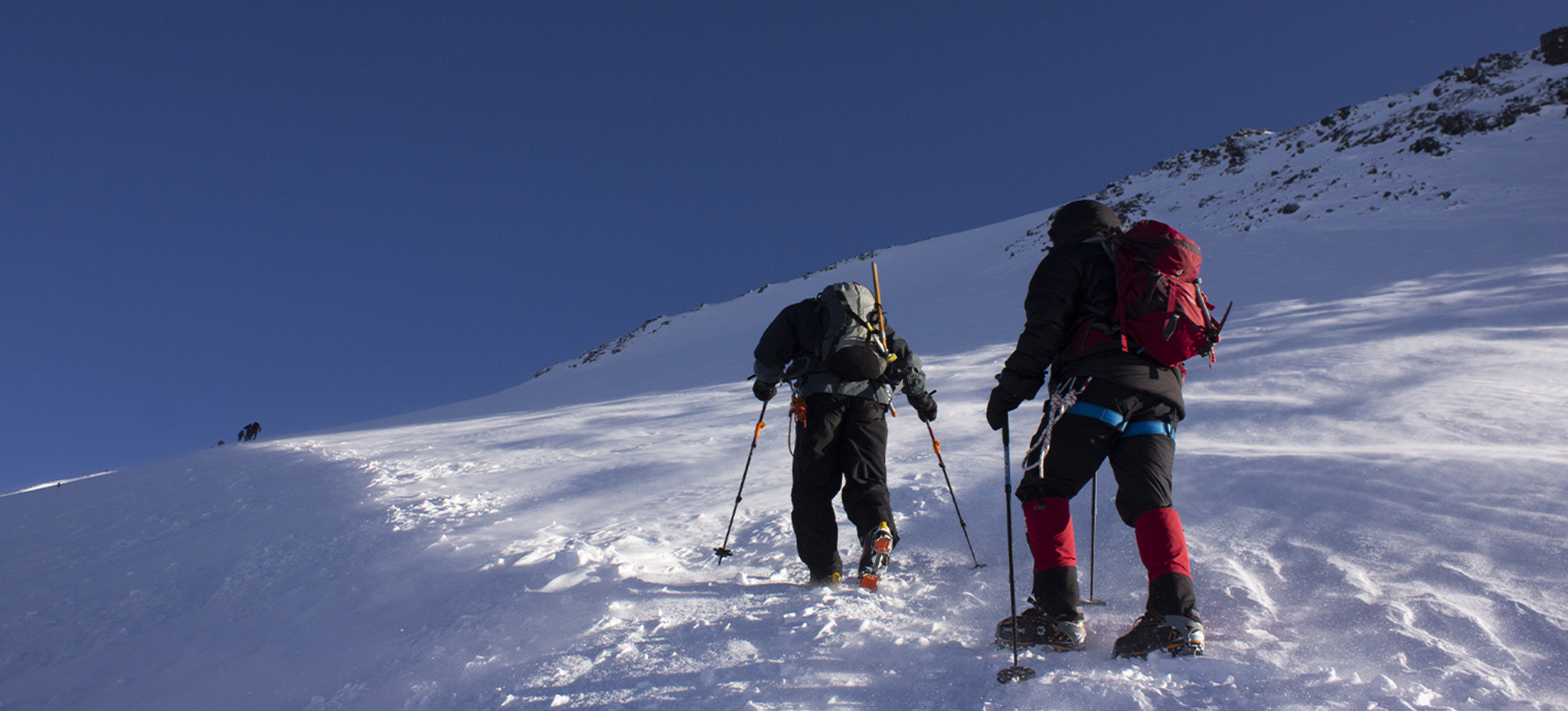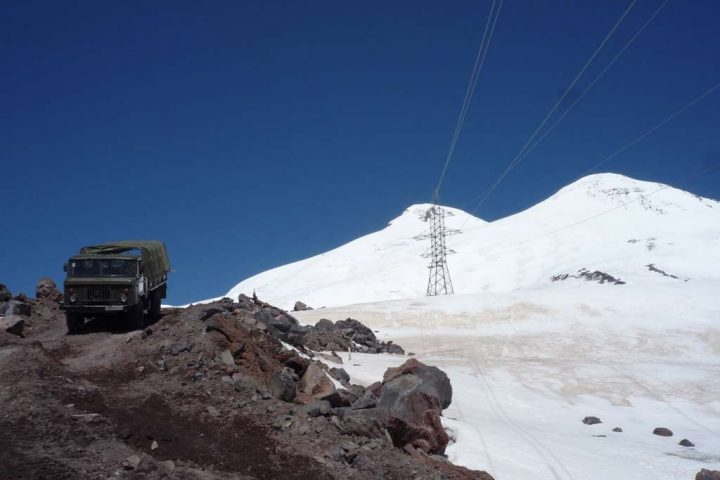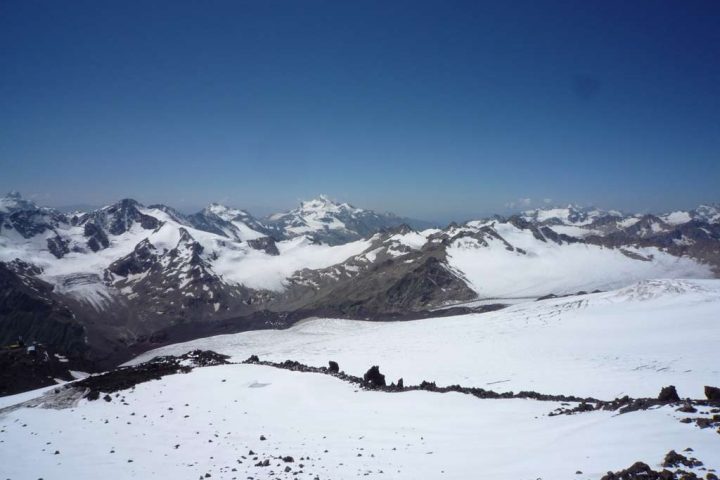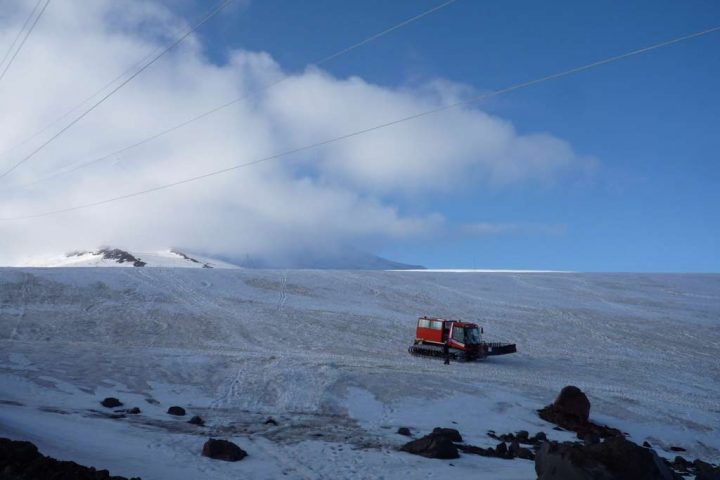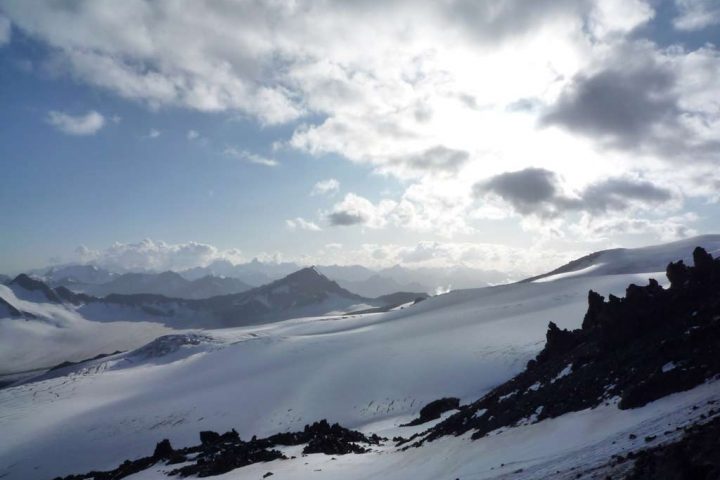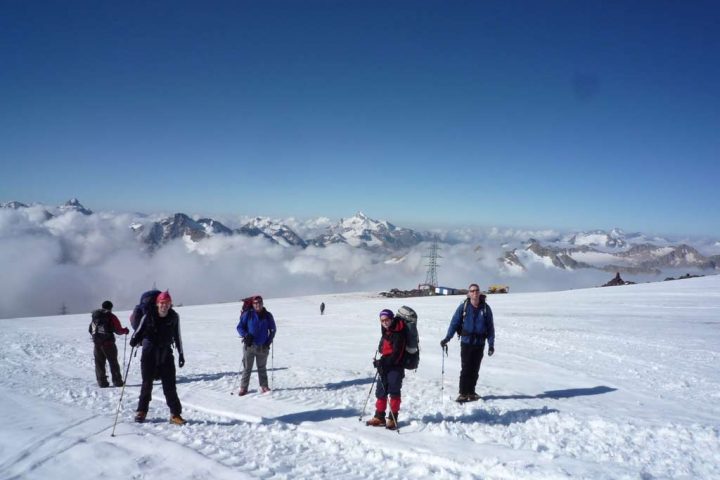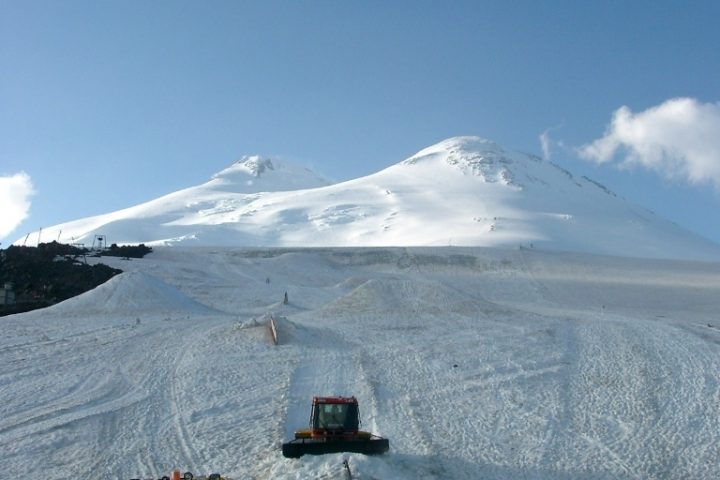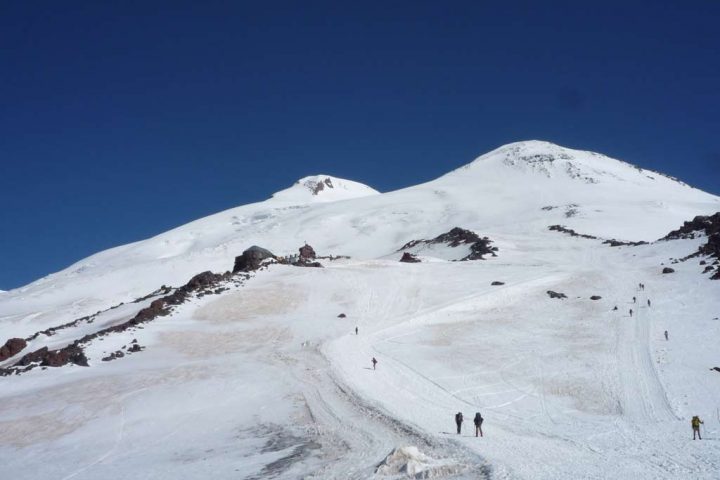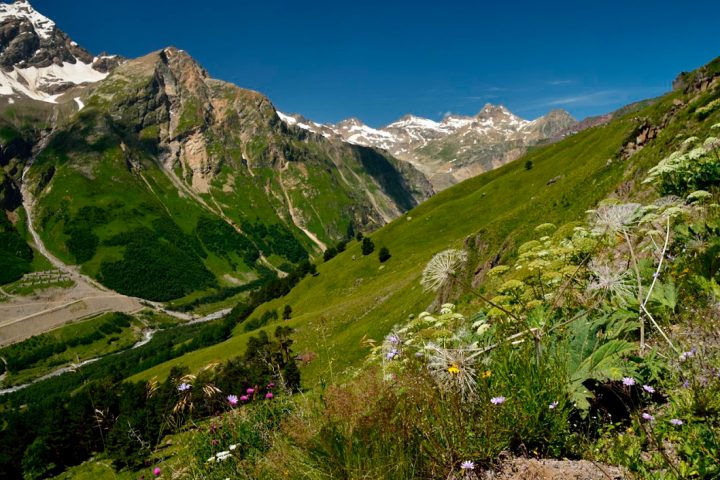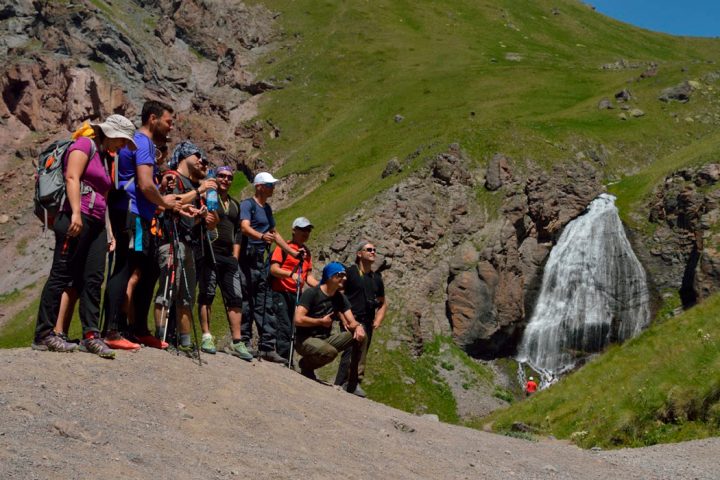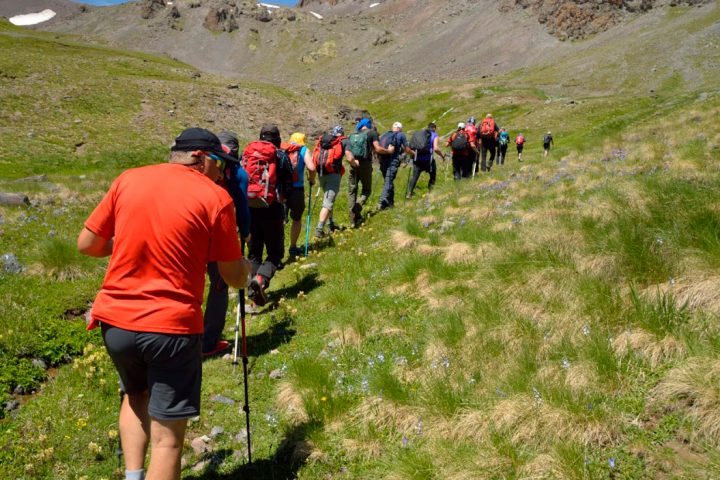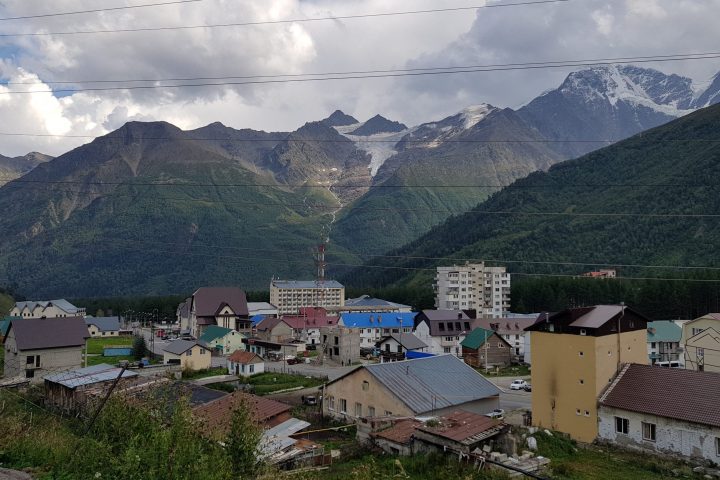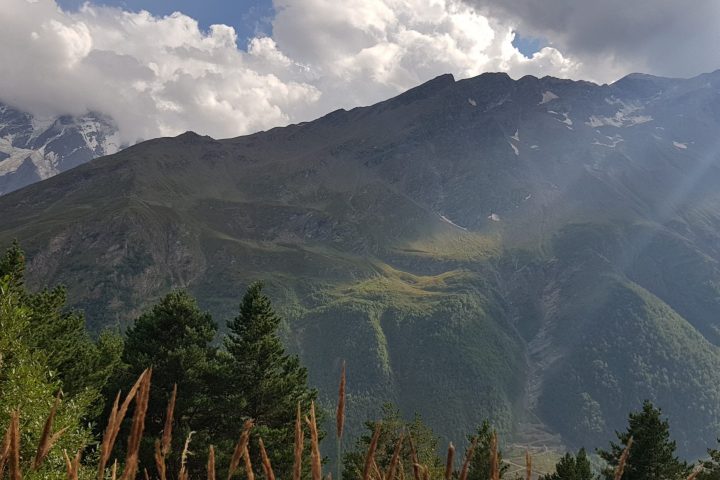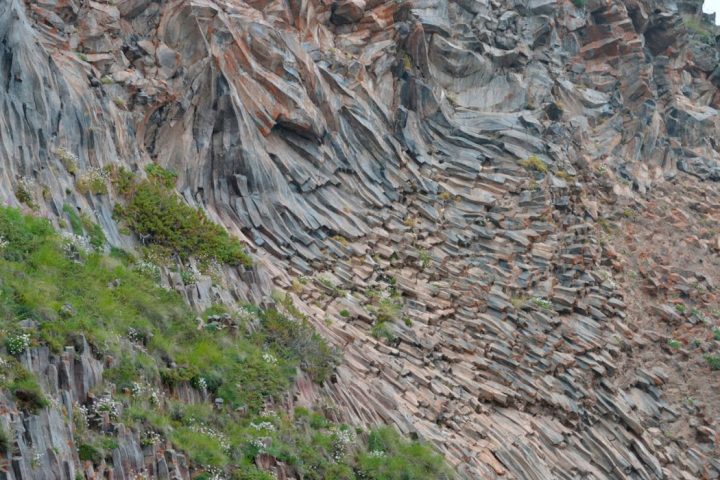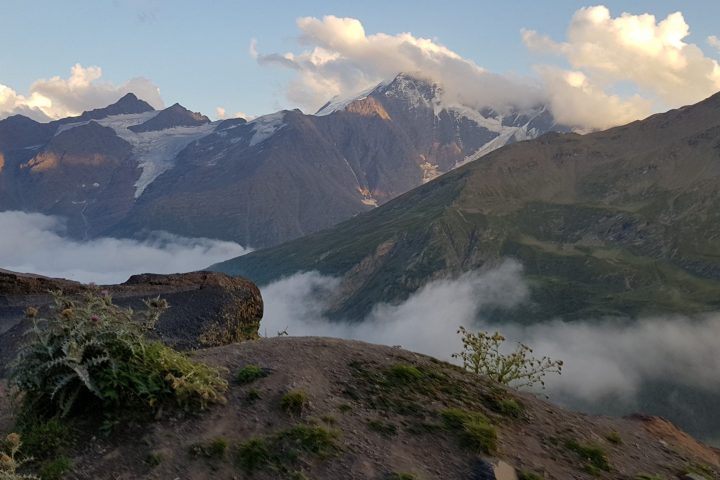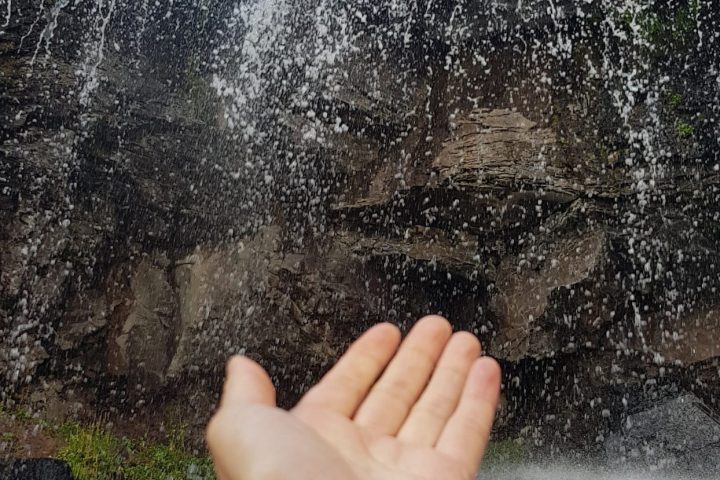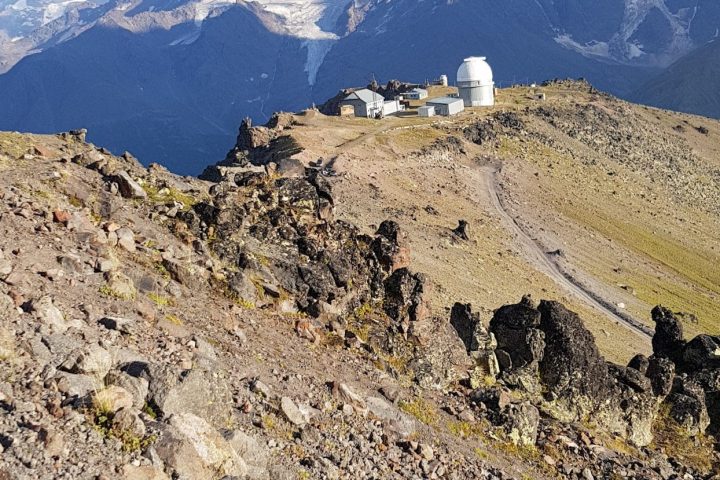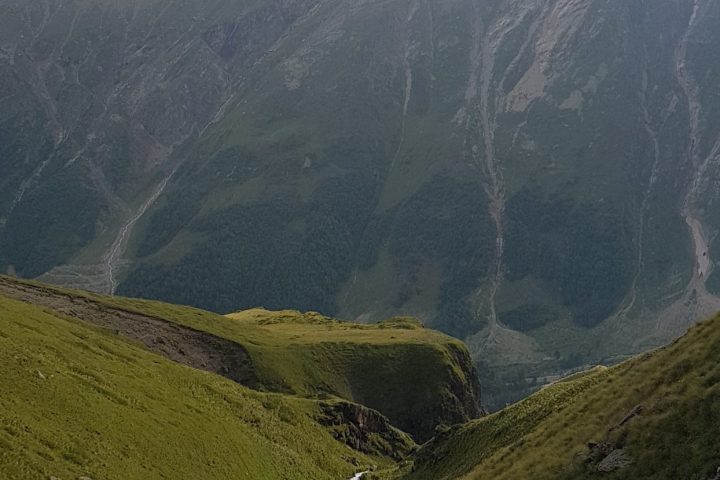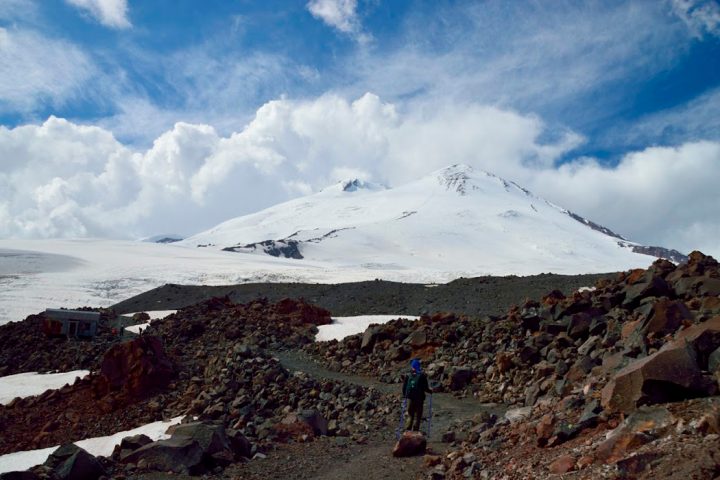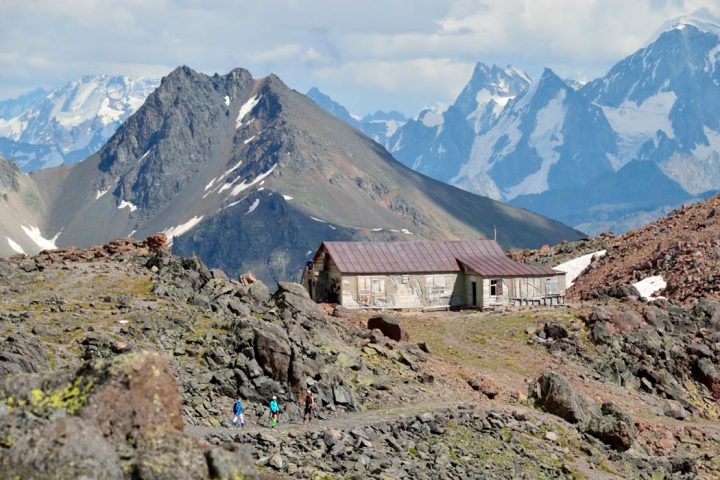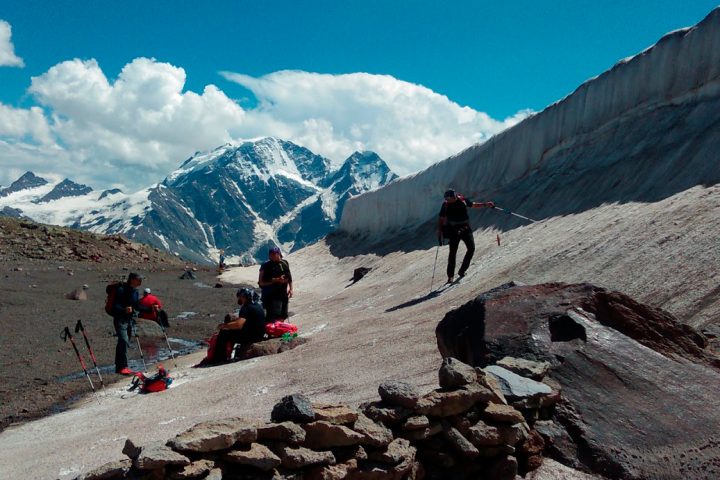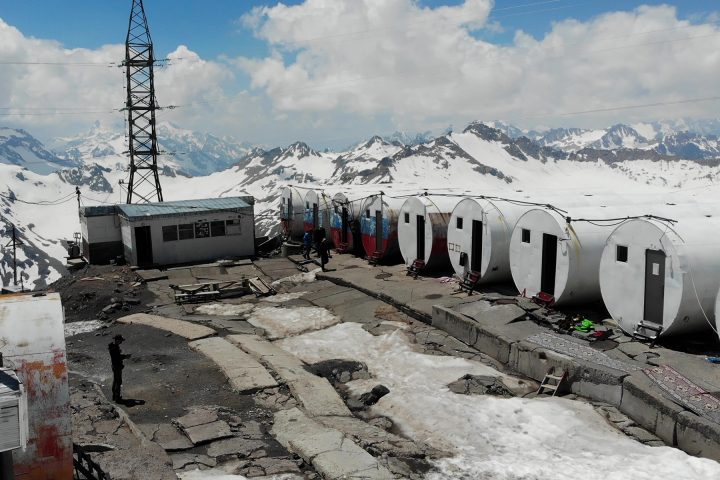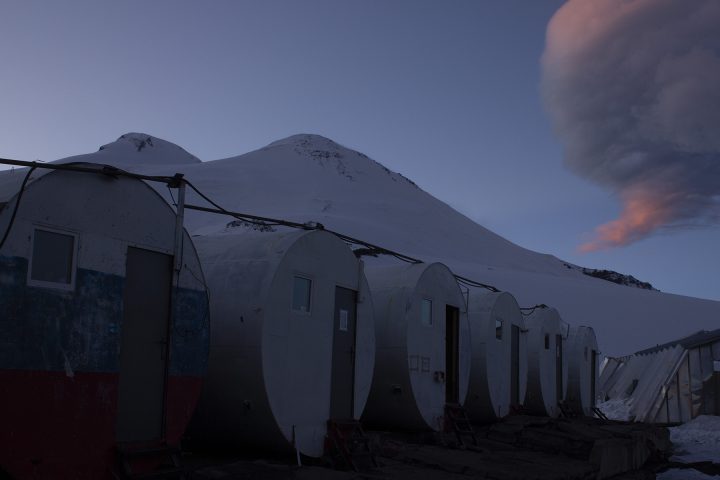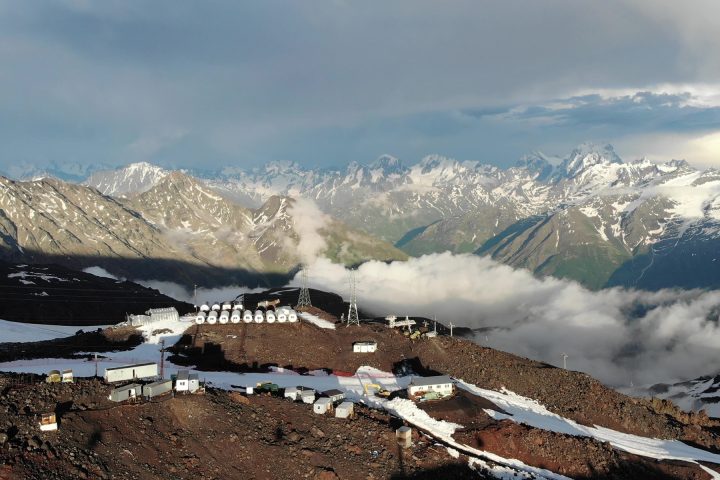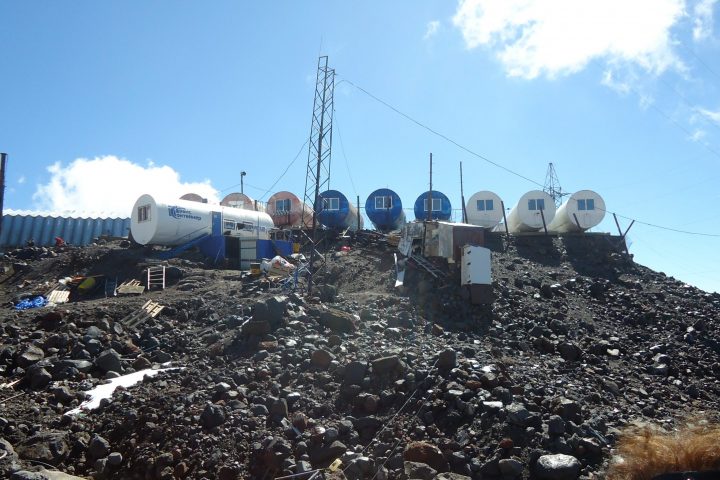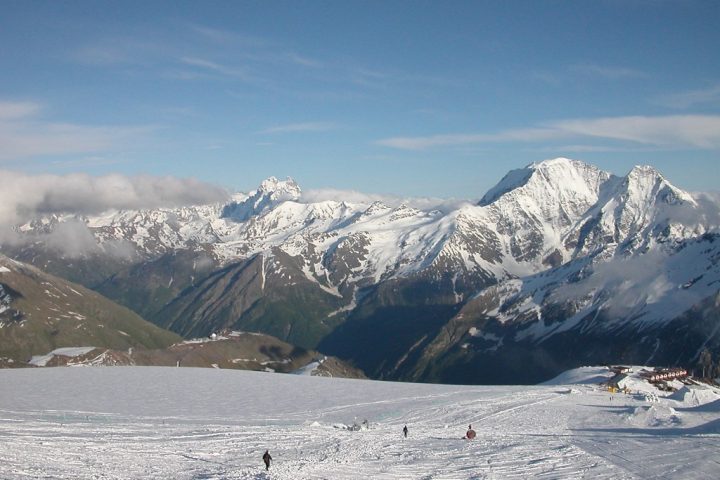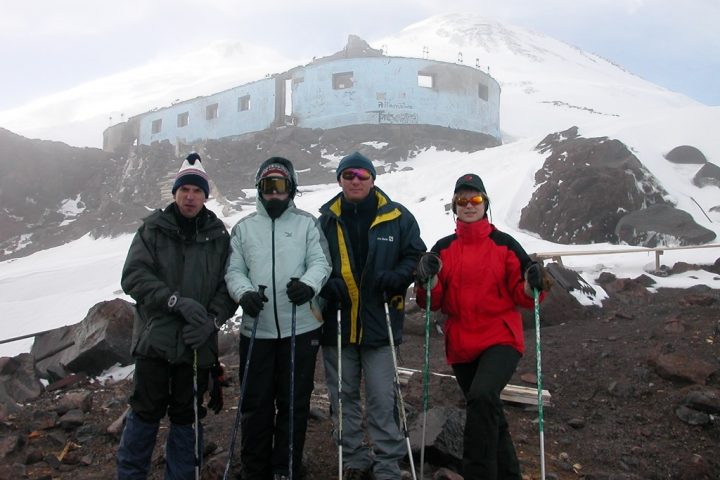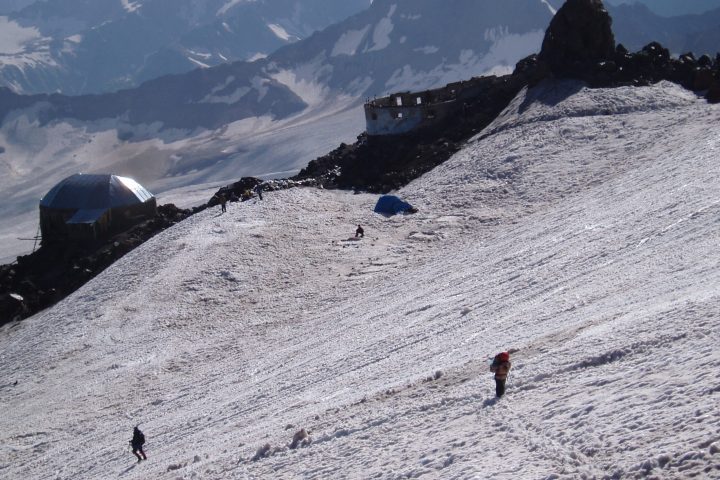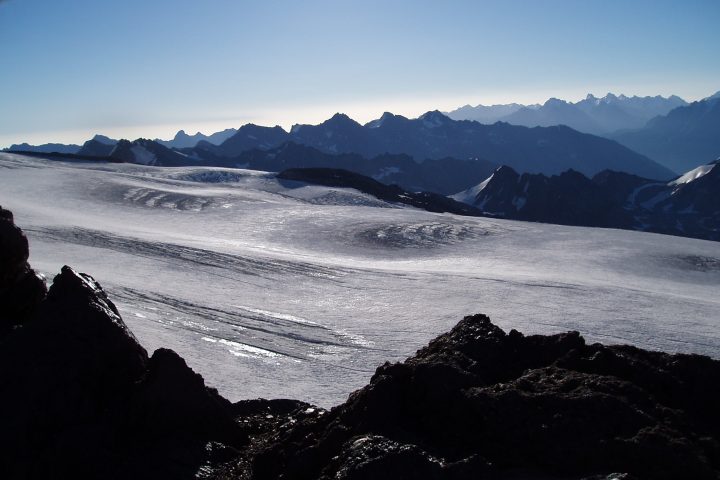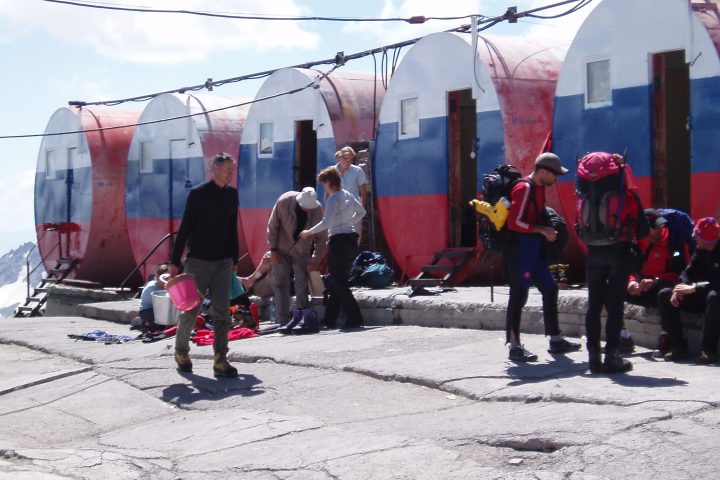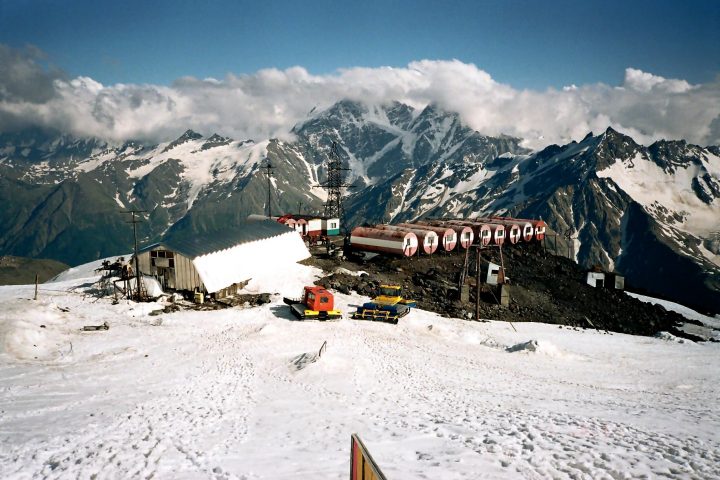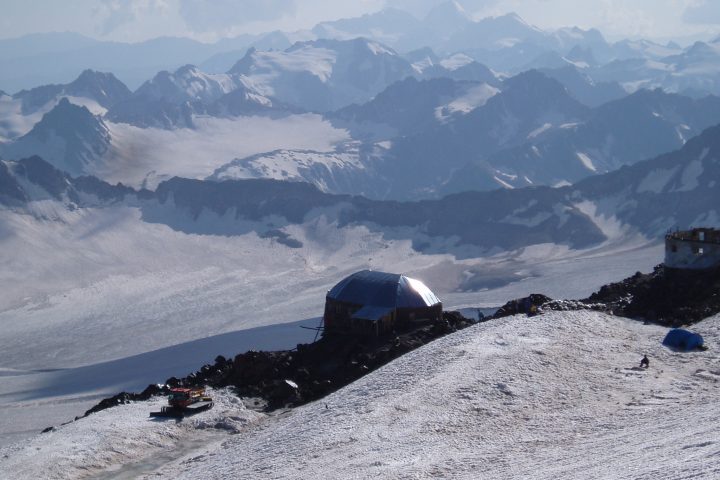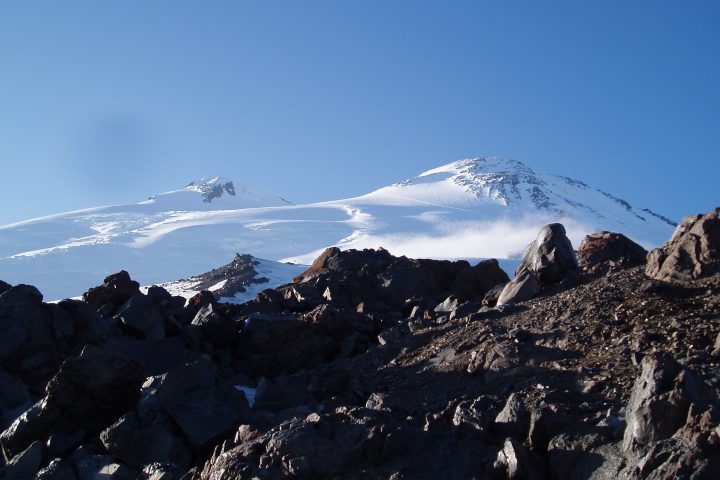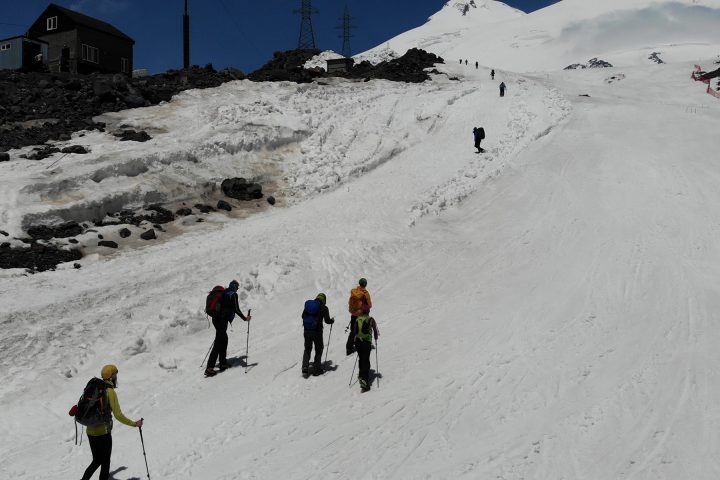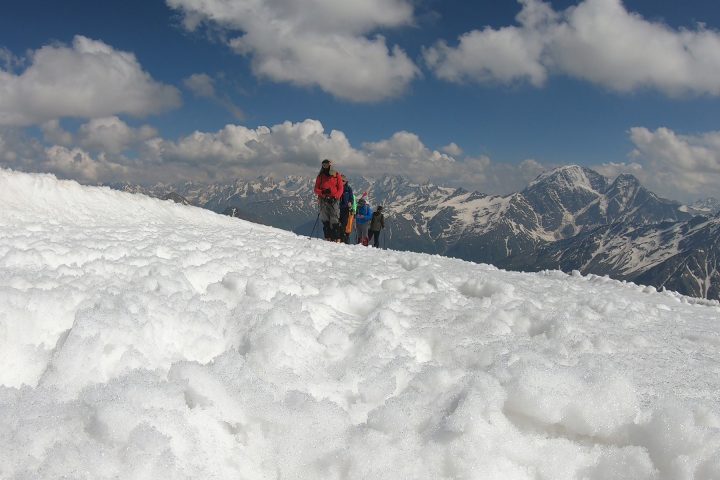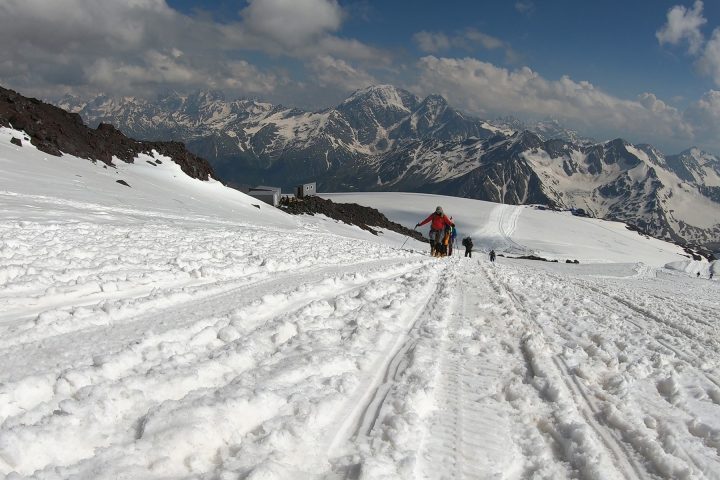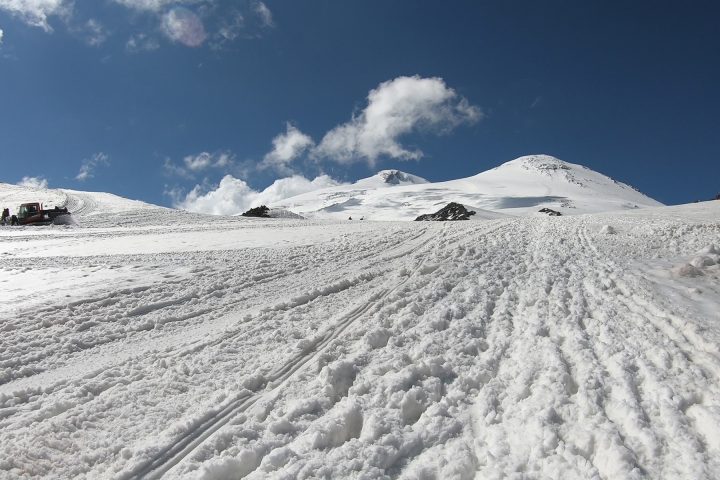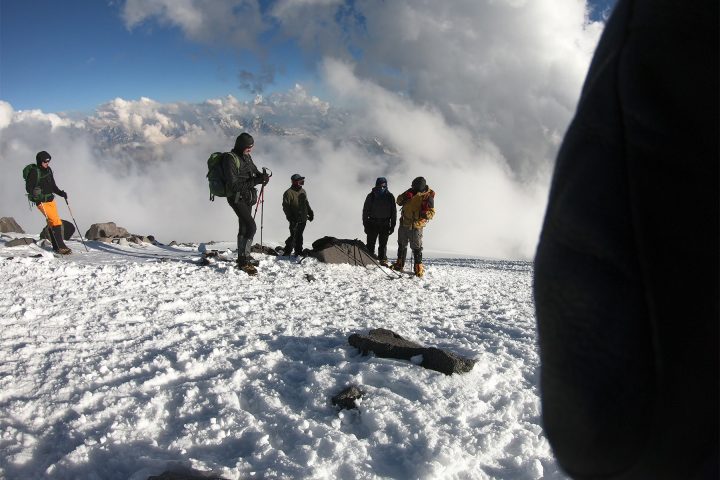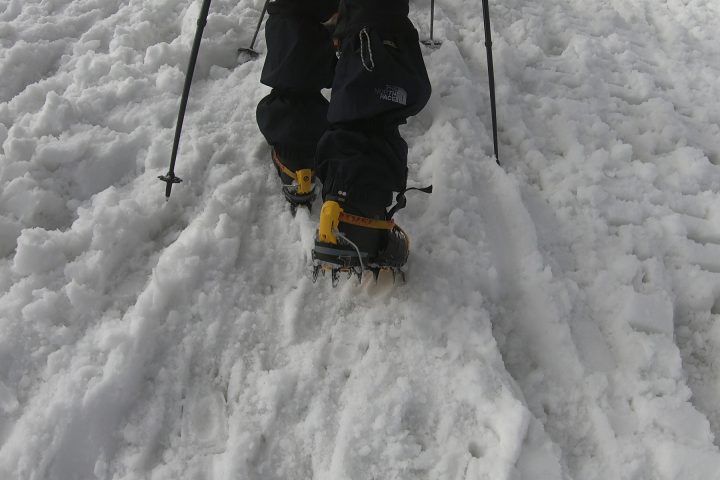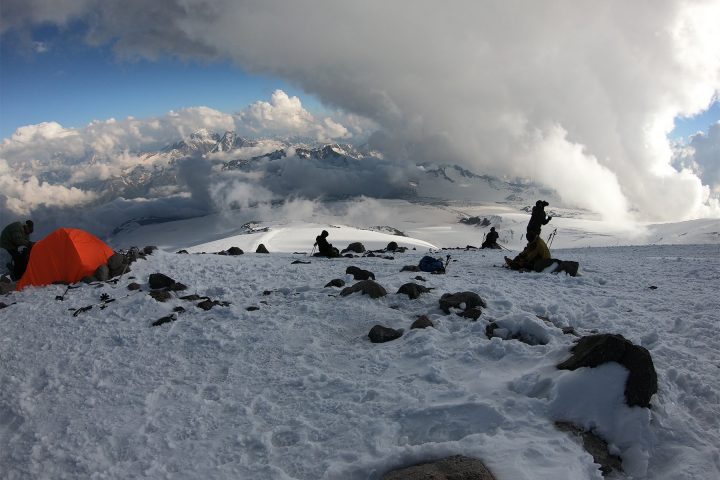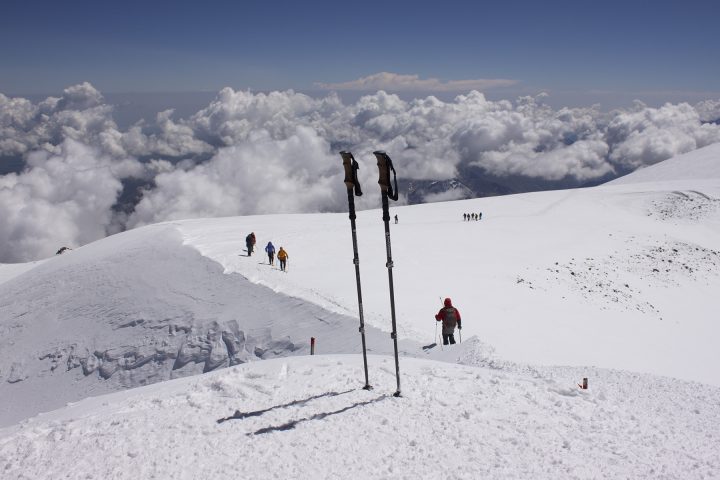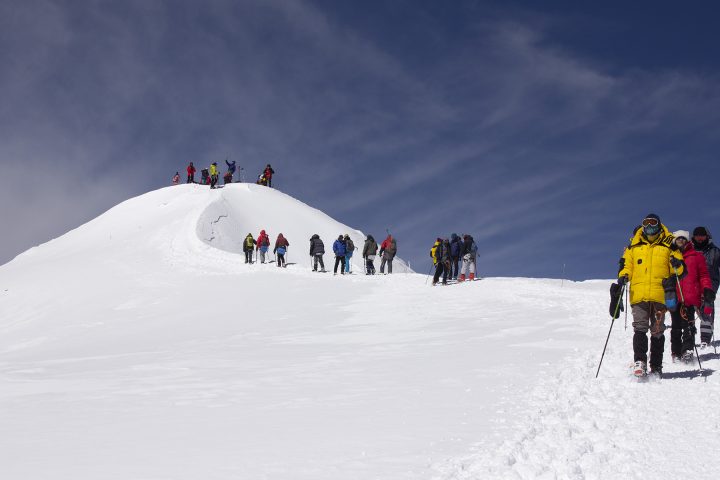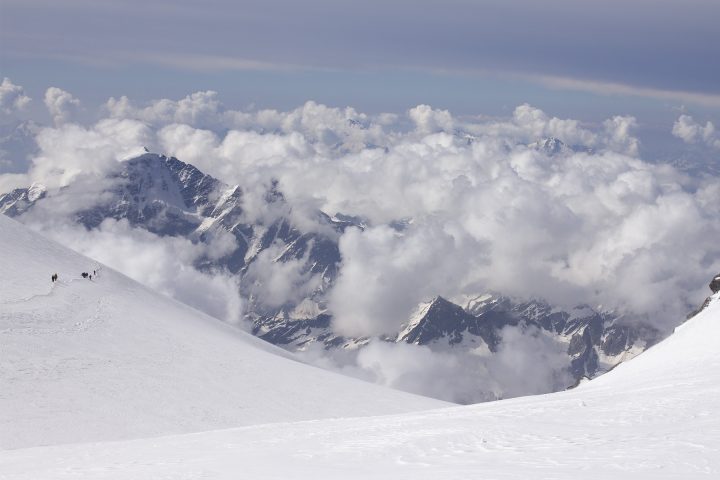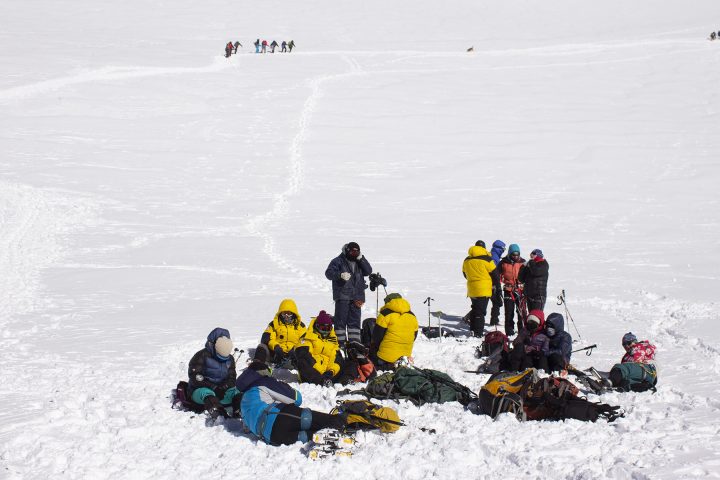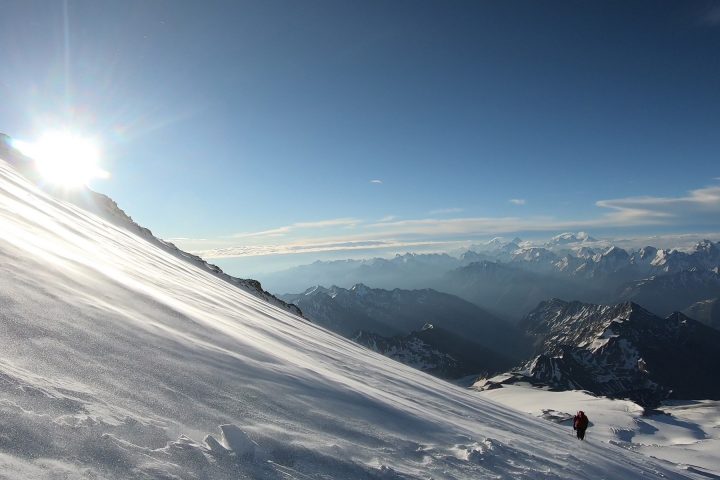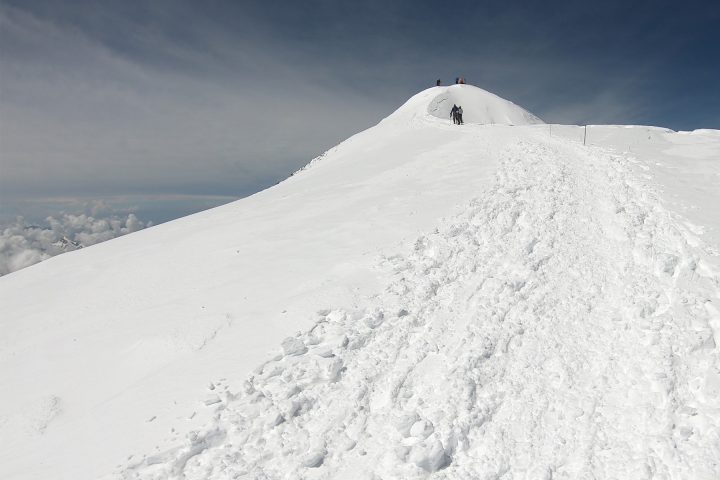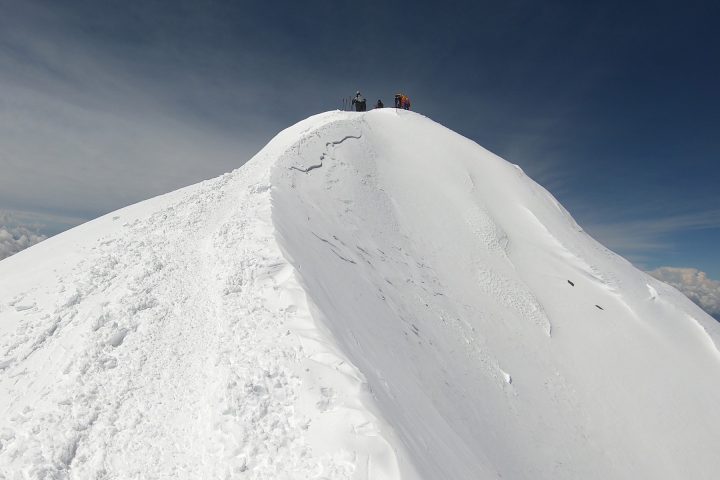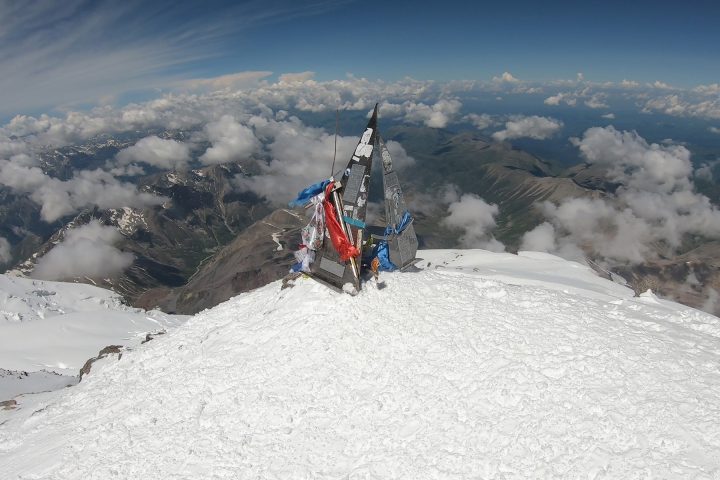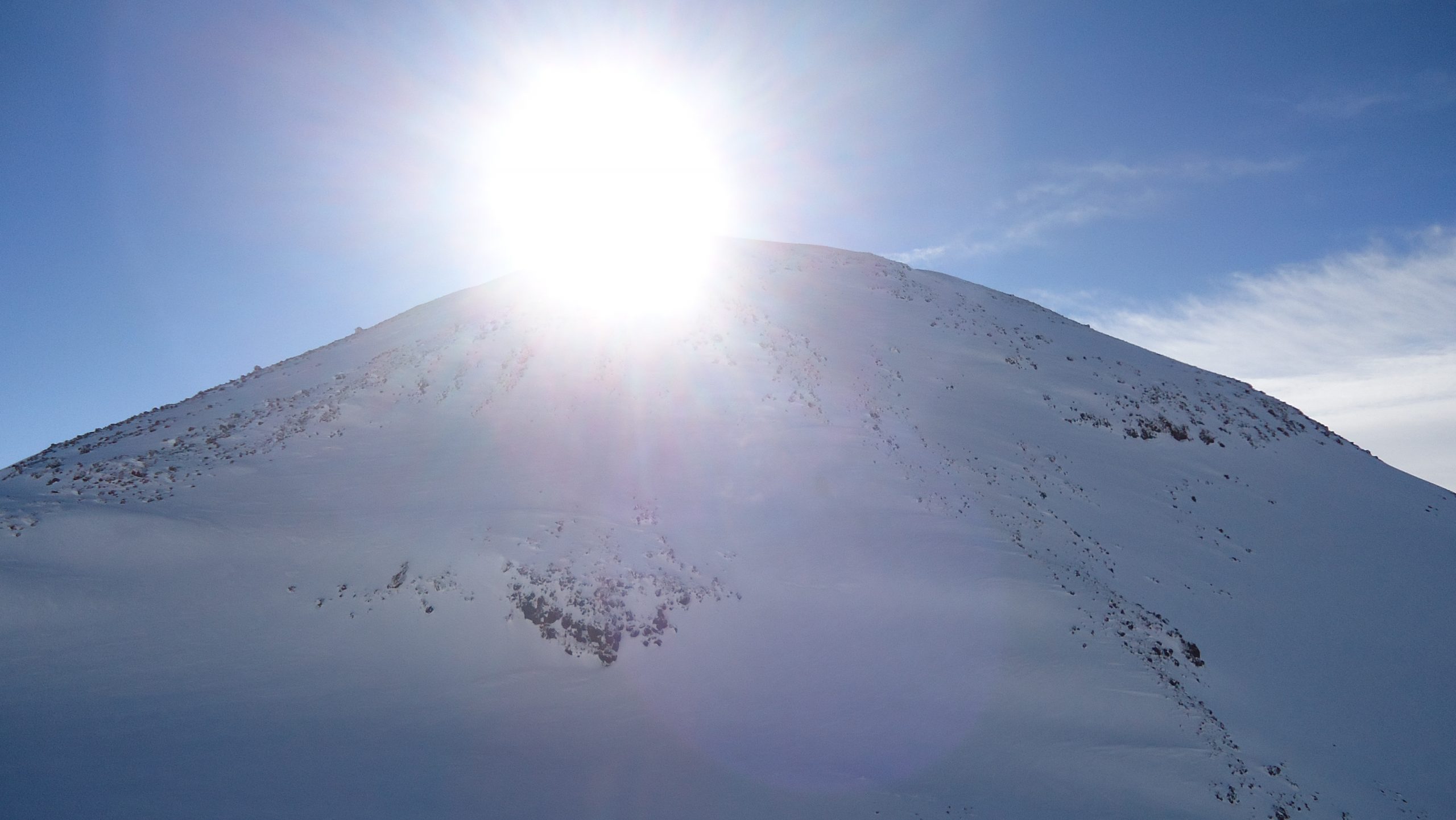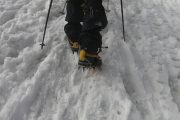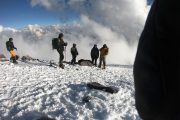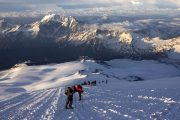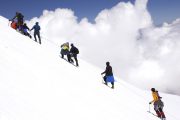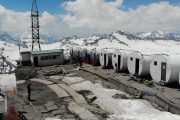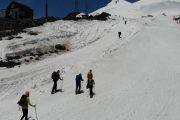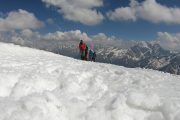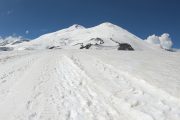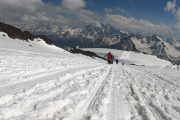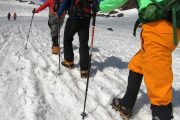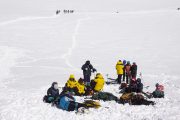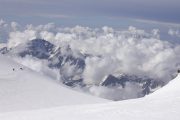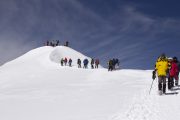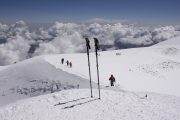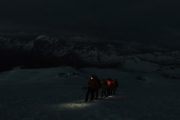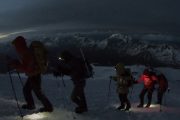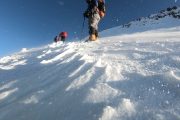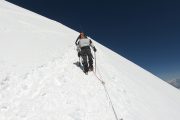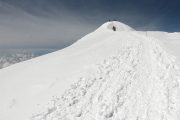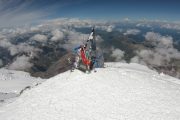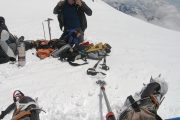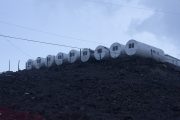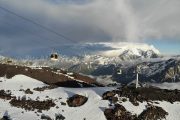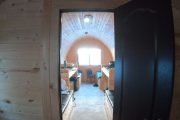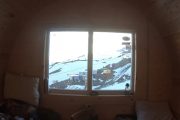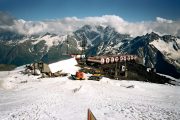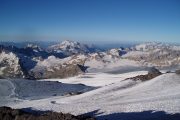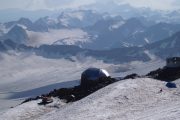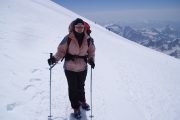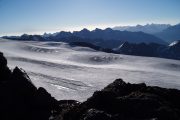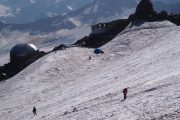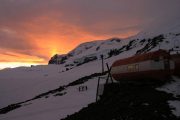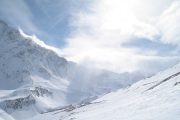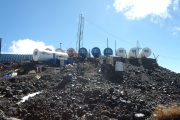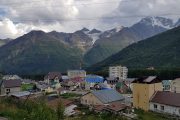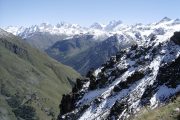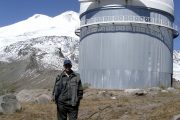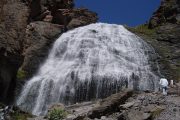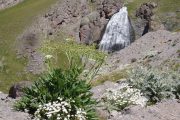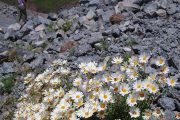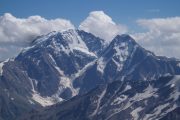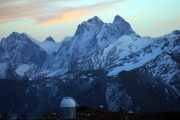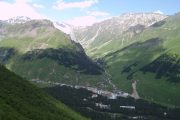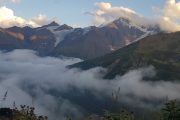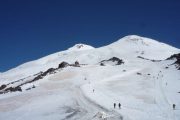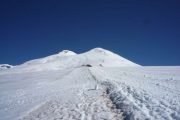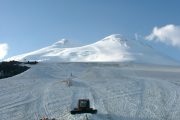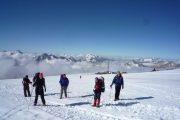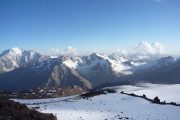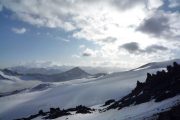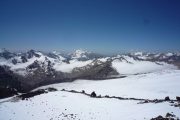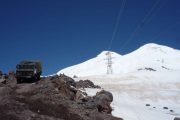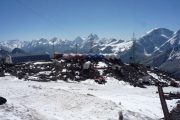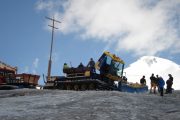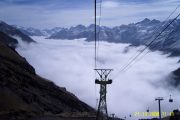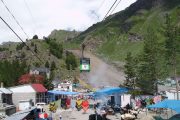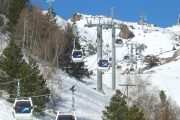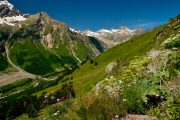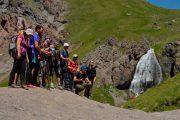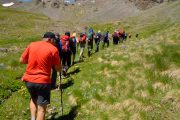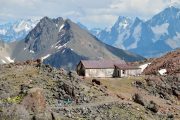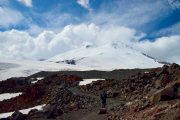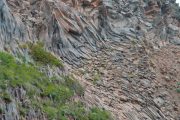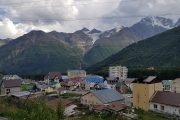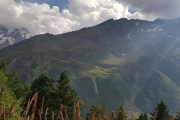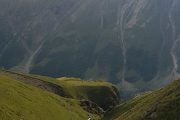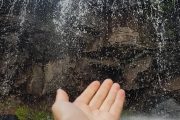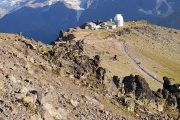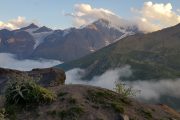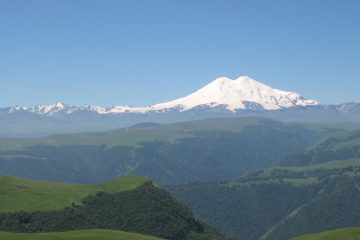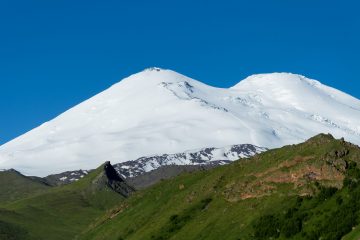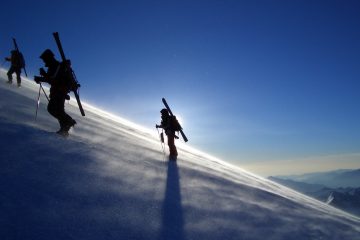WHY CHOOSE THIS ROUTE?
The route passes along a road made in 1938. Along that road the building stuffs for the building “Priut 11” delivered. A place of an ending of the road was called “Ice Base” (3800 m). From here on ice fields of Mt.Elbrus to the building site, a four-kms sledge road was made, having directed reliable bridges through ice cracks. Up to the launch of the cableway “Elbrus” it was the most popular route to “Priut 11”. Now for climbing Elbrus everyone use cable-ways “Elbrus” and “Gara-Bashi”.
Mount Elbrus with other mountains more 5000 m high belonging to Great Caucasus Ridge, attracts mountaineers from all parts of the world. The routes to Mt. Elbrus are not difficult. It is possible to reach the peak without having a high-degree qualification, but nevertheless climbing to Mt. Elbrus becomes popular more and more with mountaineers, as Elbrus is the highest peak of Europe and Russia from Portugal till Kamchatka.
From the point of view of modern mountaineering as a sport Elbrus does not present any insurmountable difficulty. There are many routes leading to its peaks, and they are all comparatively easy. The main dangerous during an ascent are the snow-covered fissures in glaciers and the low temperatures.
Elbrus is the first test of endurance, of ability to overcome the depressing effect of mountain sickness and cold. Actually, it is a fairy easy ascent in good weather. In bad weather, and especially in winter, it is not so easy to reach summits of Elbrus. Its snowy expanses have witnessed many difficult and dangerous rescues.
The main objective dangers on route of ascent to Elbrus are numerous crevasses, weather – because of its specific location and its dominant position the weather on Elbrus can change in a few hours, which, along with a decrease in visibility and a fast drop of temperature (nominal and perceived), leads to a loss of orientation and hypothermia, as well as the possible lack of altitude acclimatization of climbers and such related factors as dehydration, a significant deterioration of health and, as a consequence, loss of concentration, and so on.
In previous years the base camp for climbing Elbrus was hotel Priut-11. It was burnt in August 1998, during the sudden night fire. Constructed near former Priut Diesel hut (4050 m) can accept climbers now. Two-storey hut for 50 persons with kitchen, gas, electricity.
Now the main summit base camp is situated on mountain hotel “Gara-Bashi” (3800 m). It represents 10 “barrels” for 6 persons each, of cylinder form (in Russian so-called “Bochki”). There are two dining-rooms for 15 persons each, including gas stoves on liquid gas. Every barrel has electricity with electric heating.
For the acclimatization effect climbers stay two nights on altitude 4000 m. First day acclimatization ascent to Pastukhov’s rocks (4800 m). Early morning second day is planned the climbing to the top of Elbrus at about 2-3 o’clock a.m. in direction to the Pastukhov’s Rocks (4,800 m), then to the saddle of Elbrus, here tourists have one hour rest and go to the Western or Eastern summit.
BRIEFLY
Day 1. Meeting in Min Vody airport. Transfer to Prielbrusye. Accommodation in hotel in village Terskol.
Day 2. To the Terskol gorge, direction to “Novy Krugozor” (2900m) – bivouac.
Day 3. Continue the rout to the “Ice Base” (3800 m) through meteorological station “The 105th picket” (3300 m) – bivouac.
Day 4. Climbing to tourist’s hotel “Priut-11” (4200 m). Accommodation and lunch.
Acclimatization hike to the rocks of the “Priut-9”. Return to Priut-11.
Day 5. Climbing for acclimatization to Pastukhov’s rocks (4800 m). Returning to tourist’s hotel “Priut-11”.
Day 6. Early morning climbing to a top of mount Elbrus. Descent to Priut-11.
Day 7. Spare day for climbing. Descent to hotel in Terskol vil.
Day 8. Departure to Min Vody.
Our program includes everything you need, with the exception of personal equipment. Transfer from/to the airport, accommodation, meals, guides. Personal special equipment, as well as specialized clothing, can be rented from us.
Food. The summit camp have a full kitchen with a cook and a dining room where you can comfortably sit down for a meal or drink tea. All food is prepared from natural products and is adequate to the «mountain» lifestyle. A thermos with hot water for making tea or coffee is always available. Meals — three meals a day, a lunch package is issued on the day of the ascent.
Guides. Each of our guides is well acquainted with this Mountain, with the physiological features of the work of the human body in these conditions, as well as with many pitfalls of the human psyche, due to the combination of environmental factors and the work that a person finds himself in here. The number of guides varies depending on the size of the group. On average, there is one guide for every 3-4 climbers. Also, the number of guides is equal to how many times the group can split up during the ascent, to descend the «tired» to the camp.
Rescue team. Each group is registered with the rescuers who are on duty on the route in the summit camp.
Connection. Mobile coverage is available everywhere and, depending on the weather and mobile device, it works on the climbing route all the way to the summit.
Season. In general, the vast majority of ascents occur from July to October. The best time for climbing can be considered July and August, this is the peak season. By this time, all winter snow had already melted, it is warm, and there is a sufficient duration of daylight hours. In June and September, the ascent can also be quite successful. In June there may be more snow than in the middle of summer, but at this altitude it is spring here all around, and everything is in bloom, numerous mountain meadow flowers and rhododendrons. In September, the situation with snow and ice can be even more stable than during the peak season, but the daylight hours become shorter and the average daily temperature drops, often even at Cheget area can drop to zero at night.
Weather and climate. In high camp at night, the temperature drops below zero, however, due to the dryness of the mountain air, it feels mild. During the day, streams of melt water flow here, the sun shines brightly, clouds form in the evening, but on bad weather days it is quite harsh here: the wind can reach 60-70 kilometers per hour in gusts, it even happened that it carried away the houses fixed with cables; a lot of fresh snow may fall, and revenge for a couple of days, a thunderstorm with hail may come, and then the camp is located right in its epicenter.
Acclimatization hikes can take place in good weather conditions, with the sun, blue skies and light clouds. And they can pass through very difficult ones — rain, wind, hail, dampness, cold. On acclimatization days, hikes take place in any weather (the exception is a strong thunderstorm, but usually it does not last long and is simply waited out). In general, the morning and the first half of the day have the best weather conditions, in the evening the weather can become more daring, so the main part of the work takes place in the first half of the day.
Acclimatization access to snow and ice coincides with the ascent route, and, in addition to adaptive goals, also pursues the goal of mastering or updating the skills of walking on snow and ice in crampons, walking in a bundle, optimizing other processes associated with work during ascent.
All these walks and transitions are quite long and energy intensive, so you need to try to have a good rest in between, in order to try to approach the moment of ascent in optimal shape, acclimatized, but not too tired.
Weather on summit day. On the slopes it can be quite severe and even so it is considered acceptable. For example: a wind of 20 m/s – it is a normal working weather, those who doesn’t know that its permanent here can turn back thinking that he was blown off. Over the slope the situation with the wind may be different. It happens that before the lower Pastukhov rocks it is relatively calm, and from the border of rocks abruptly begins to blow. Sometimes vice versa – in the camp the strongest wind and slightly higher on the slope it becomes calmer. The air temperature in the upper part of the route can drop to -20 degrees, and in the sun can also be same number but in different direction. When the sun does not shine and comes the wind and clouds you are as if in the freezer. When the sun fries – as if in a stove. So you need to be prepared for such features.
Join our groups. We have :
- Guaranteed meetings and transfers from/to airports Mineralnye Vody or Nalchik at any dates and time.
- No additional fees for transfers.
- It is also possible to join the group later or leave earlier.
- The most experienced and professional guides on Elbrus english speaking.
- We have been in the service since 2003 and therefore have a great experience of successful climbing trips and satisfied tourists.
- Convenient amount of tourists in the groups — from 3 pax to 10 pax maximum (not more).
- Support from our office 24 hours in the city of Nalchik, with a close location from Elbrus, which allows us quickly resolve any issues that arise during the trip.
- Security support and quick contact with medical, emergency and insurance agencies.
- Additional excursions to other areas of our republic in case of free days.
PRELIMINARY APPLICATION
Tour Description
Day 1: Arrivals.
Meeting at the airport Nalchik or Minvody, transfer to a private hotel in the Cheget glade. The road to the Elbrus region begins with an air flight to the airports of Mineralnye Vody or Nalchik. The nearest railway stations are Nalchik, Pyatigorsk, Prokhladny, Mineralnye Vody. Then there is a direct road connection with the village of Terskol. Travel time from the Mineralnye Vody to the Elbrus region is 3 hours, from Nalchik 2 hours.
During the day. Hotel accommodation. Checking missing personal equipment. Renting for an additional fee.
Dinner at the hotel.
Instruction on the program and safety precautions. Signing safety instructions.
Free time, rest, walk.
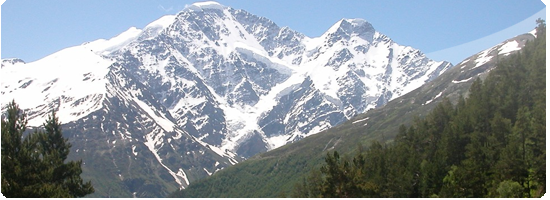
Day 2: Climbing mount Terskol.
Breakfast at the hotel.
From village Terskol to “Novy Krugozor” 2900 m (New Outlook) – bivouac.
The route passes along a dirty road branching off from the Baksan highway in the village of Terskol (2200 m). The road goes first to the valley of the Terskol river. After 10 minutes, the ascent to the left side of the valley begins, to the slope of the relatively small southern spur of Elbrus. This spur, composed of volcanic rocks, separates the Garabashi and Terskol glaciers. We gain altitude with long serpentines and exit the pine forest to the grassy slopes above the Baksan valley. Above them are areas of picturesque basalt rocks. After 2.5 hours the road turns north, to the transparent multi-jet waterfall Devichi Kosy. This is the first stream along the way. From here we rise to the hanging valley and approach the houses of the «New Outlook» (2900 m). Near the shelter there are convenient places for tents, a clear stream. The way from Terskol will take 3 hours.

The route will allow you to admire the majestic panorama of the Main Caucasian Range. The Baksan glade, the tops of the Mt. Ushba, Mt. Donguz-Orun, Cheget and etc. are well seen from the houses. On the opposite slope the ski lifts and famous Cheget mountain-skiing lines are viewed. In pink rays of the sunset the summits of the Main Caucasian Range are most effective in the lateral (western) illumination. Furthermore if the Baksan glade is filled with clouds, there is a unique feeling, as if you are on an abrupt coast of the gray-haired foaming sea.
Day 3: Continue the rout to the “Ice Base” (3800 m) – bivouac.
We leave for the “Ice Base” (3800) in the early morning. Mount to the crest of the ridge and move along it in the direction of Mt. Elbrus. In an hour we approach to the small lowering of the crest on which located houses of a meteorological station. This is “The105th picket ” (3300 m).
On the approach to the meteorological station, to the right of a road is the monument to the cavalrymen of the 214th regiment defending the approaches to the Mt. Elbrus during the Great World War. On a broad rocky crest the firing points, odds of the fortification and dugouts are remained. War actions had been running here till the middle of August up to the beginning of November of 1942. The first who had taken up a stroke of the mountain forest men from the division “Edelweiss” exploding from the slopes of Elbrus into the Baksan glade were the cavalrymen of the 214th regiment. By the end of September they were replaced by the soldiers of the 897th rifle regiment.
Above “The 105th picket” the path is choked with rocks, covered by landslides, however it’s difficult to go along it. The glade of the Terskol river and the glacier of the same name hanging above the glade and covered with cracks are well visible from it, as well as a southeastern crest of Mt. Elbrus with a predominant summit Terskol (3787 m). We mount the top of an ancient flow. Both summits of Mt.Elbrus and the glacier Gara-Bashi are well visible. For 3 hours of the way from “Novy Krugozor” we leave for “The Ice Base” (3800 m) – a flat moraine site near upper reaches of the Terskol glacier. Here is a small house of the tourist shelter and the constructions of the scientific station “Ice Base”. “Priut 11” is well seen from here. It’s one and a half hour to reach it, however it’s dangerous to go there without special equipment and necessary skills. Besides it needs a special permission of the Elbrus Control and Resque Service – bivouac.
The Terskol Peak Observatory is an international astronomical observatory founded in 1980 on Terskol Peak by the National Academy of Sciences of Ukraine, 3 km from the top of Elbrus (at the foot, on the southern shoulder of Elbrus), at an altitude of 3150 meters above sea level.
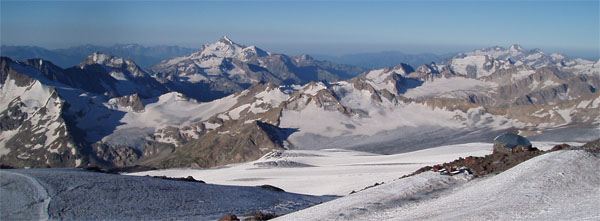
Day 4: Leave for the base camp “Priut-11” (4050 m).
One can go on moving only at good visibility. A gently sloping part of the path along the glacier leads to the take-off to Priut 11. There are masked cracks, therefore it is not recommended to go aside the path. An altitude of the Priut is 4050 m.
Above the take-off opens eastern ice fields of Mt. Elbrus. Above them raises its eastern summit. Under the summit, on rocky exits, there was constructed the building of “Priut 11”. To the right of it at the same altitude are star-shaped exits of rocks of the“Priut 9” (there are no constructions there). Above them, on a snow slope under the summit is “the Priut Pastukhov” (4800 m).
From “Priut 11” there are well visible ridges of the Western Caucasus. More to the left of the ascent way on the rocks between Gara-Bashi and Terskol glaciers seen the “Ice Base”.
Having settled at “Priut 11”, we can make a radial hike to the rocks of the “Priut 9”. One must take in account that on the Gara-Bashi glacier there are a lot of cracks, the path is not marked, and under the rocks there is a large crack – bergshrund – masked by mild snow.
“Priut11”, the highest hotel in Europe and Russia, burnt in August 1998 during the sudden night fire (nearby constructed alpinist’s hut). From here you can see the wonderful views of the mountains of the Central and West Caucasus. The both summits of Mount Elbrus are seen on the north. On the east, southeast and south you can see the Greater Caucasian Range and its northern spurs. The ranges of Svanetia are seen behind the Greater Caucasian Range, on the Southwest, behind the Hotu-Tau Range, the West Caucasus and its ranges are seen.
Day 5: Acclimatization day on the Pastukhov rocks 4700 m.
Breakfast at the base-camp.
Training hike to the Pastukhov rocks (4700 m) along the snow-ice field, between two rocky ridges. Lunch (on the way during one of the stops).
To obtain an acclimatization effect, it is necessary to spend at least two nights at a height, while on the first day a training day to the Pastukhov rocks is made. Return to the Gara-Bashi base.
Acclimatization-training ascent to the lower boundary of the Pastukhov rocks to the height of 4600-4700 m. (Scheme coincides with the line of the route of ascent).
The start of ascent is optimal at around eight o’clock in the morning in order to use the best, the first half of the day because of the weather. Depending on the condition and training of the climbers this already “fighting” ascent, can take “from the camp to the camp” from three to six hours.
Goals of this ascent are several, and they are all important:
1. To practice walking on ice-snow slopes in crampons in the group.
2. Gain of height to acclimatize (improving the quality of blood in terms of oxygen transfer).
Clothing. Today all the same clothes as for climbing day. In general, the ascent is going in the whole complete set of clothes and equipment as for the summit, in which you will go directly to the top. The difference of today from climbing day – we leave at eight o’clock in the morning – not as cold as the night when there is a climbing to the mountain. Because of that some warm clothes may not be necessary, but worth to take it anyway, in case of worsens of the weather. Again, depending on the individual thermo regulation, someone may not need a “full” set of recommended clothing and hike of this day makes it also possible to “adjust” your own set of clothes before summit.
Equipment – climbing boots, crampons, harness, poles, headlamp flashlight, and sunglasses.
Food: Hiking will not be so very long to become very hungry, but a thermos of tea and some sweets you can take, again, the question of how the body requires or not the feeding during physical activity.
Day 6: Rest day or climb/reserve day.
We rest, eat and gain strength for the ascent.
Or climbing day depending on the weather conditions and the preparation of the group.
Early dinner at base-camp.
Preparation of equipment for climbing Mount Elbrus. Instruction on the climb and safety precautions.
Early sleep.
Day 7: Summit day.
Early rise (01:00-02:00) and breakfast, light snack.
Climbing to the top of Elbrus (5642 m). In the morning begins the ascent to the top. The start of the ascent is planned for 2-3 am. For an additional fee, if desired, you can climb on a snowcat (about 5,000 rubles per person) to the Pastukhov rocks 4800 m. The ascent takes place along the path to the Pastukhov rocks, or a few minutes of ascent on a snowcat — a special mountain snow tractor.
From the Pastukhov’s Rocks the ascend route directly ups 300-400 meters and then smoothly turns left across the slope and reach the saddle 5300 m. Here we rest for 1 hour and go to the Western peak 5642 m.
It takes 6 or 8 hours from the summit camp to the saddle. On the left side of the saddle, under the west summit slopes, near the beginning of the snow mould the hut construction is situated. At the distance of 250 – 300 meters above the hut the route turns left from the saddle and over the snow slope with the simple rock places up to the rock shoulder. From the shoulder over the wide horizontal plateau comes to the round on the Mount Elbrus west summit (5,642 meters). It takes 1,5 or 2 hours from the saddle to the summit. It takes 5,5 or 6 hours for the descent to the Gara-Bashi going along the ascent line.
Descent to the base-camp.
Descent into the valley.
Day 8: Departure.
Transfer to airport MinVody or Nalchik. Departure to Moscow, Istanbul etc.
| REQUIRED EQUIPMENT FOR THE EXPEDITION «CLIMBING ELBRUS»: | GROUP EQUIPMENT: |
|
|
| SERVICES | STANDARD |
| Airport transfer (railway station) Nalchik/Minvody — Elbrus region — airport (railway station). | |
| Accommodation in a hotel in the Elbrus region, according to the program 4 days (breakfast, lunch packages, dinner). | |
| Accommodation at a mountain summit camp Gara-Bashi, according to the program 3 days, standard (three meals a day + lunch packages). | |
| Ascent by cable cars to summit-camp Gara-Bashi (1 ascent — 1 descent). Gondola and chairlift cable cars. | |
| Inside the route transports. | |
| Guide services throughout the route (english speaking). | |
| Extra Guides for the day of climbing, one guide for 3-4 climbers. | |
| Cook at the mountain base of Gara-Bashi. | |
| Resort fees, Elbrus National Park. | |
| Visa support letters and visa registration. | |
| Rental of personal equipment. | |
| Ratrak for the day of ascent to the Pastukhov rocks. | |
| Accident insurance. | |
| COST | 85 000 rubles. |


 +7 928 691 44 05
+7 928 691 44 05 
 Russia, KBR, city Nalchik
Russia, KBR, city Nalchik




